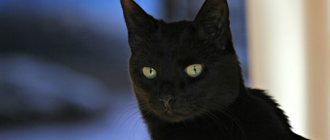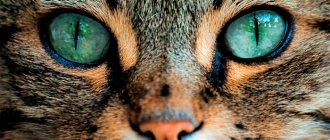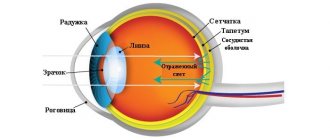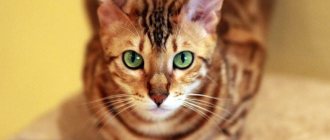Any cat owner, after some time, wonders how the animal behaves in certain situations, why it can navigate well in the twilight, knows perfectly well where the potential victim is hiding, and when the owner will come home from work.
The main thing that provides cats with the opportunity to determine a possible impending threat or victim is their perceptual organs, which are different from humans. A cat sees, hears, and smells differently.
Despite the fact that cats see and hear completely differently, the main thing that allows cats to perfectly navigate the surrounding space is their sense of smell. All animals live in a world of aromas and different smells, and cats are no exception. A domestic cat that has lost sight or hearing can survive in the wild without much difficulty, but without a sense of smell, the animal’s life is at risk.
The environment for cats is always filled with a wide variety of smells and aromas. For a mother cat, the most important thing is the smell of her children, owner and other household members. All cats perfectly distinguish where a good person is and where an enemy is.
The smells of food are also specific to cats. Those aromas that are clearly unpleasant or even repulsive to the human nose are pleasant to the cat's body. For example, the smell emanating from fermented offal or fish remains is extremely attractive to the pet, especially at a time when the cat is feeling hungry.
But a bowl for food or water washed with special products until clean can repel a cat, since it picks up odors from products that are not perceptible to humans.
In the world of smells in cats, the smells of marking territorial boundaries, as well as the smells released by females during sexual heat, are of particular importance. Using special marks, cats are excellent at determining where the territories are that it is not advisable to enter, and where the places of potential enemies are.
Thanks to their sense of smell, cats determine where the female is ready to mate. A hungry predator is able to calculate over long distances where the prey is running.
Vision in cats
Cats have binocular vision that is 6 times sharper than humans. The special arrangement of the eyes allows them to capture objects at an angle of 205 degrees, which is 1.5 times greater than the ability of humans. They simultaneously observe what is happening from three sides. Among pets, cats have the largest eyes relative to their body proportions.
In a limited color spectrum, cats recognize 6 colors and many shades, but see them as less bright and contrasting compared to humans. The ability to visually accurately determine the distance to an object of interest makes them dexterous hunters.
The pet's pupil is surrounded by a movable iris. The shell is driven by muscles connected to the spherical eyeball. The pupil, reacting to the degree of illumination, unevenly expands or contracts, protecting vision from the entry of excess light. Foxes have a similar ability.
Cats distinguish moving objects well, but perceive static ones worse. When a mouse sees a predator, it freezes in the hope of remaining unnoticed. The cat sees clearly at a distance of 1-6 meters. She will see a rodent from a 60-meter distance, and she will notice a moving object at 700 meters.
It is a common misconception that felines quickly become accustomed to the dark thanks to their glowing eyes. The glow is explained by the ability of the eyes to accumulate reflected light. Pets cannot see in pitch darkness. Rays of light penetrating into a dark room are caught by the cat. This improves orientation. The light sensitivity of her eyes exceeds human eyes by 7 times.
Another feature is the presence of a third eyelid, located in the inner corners of the eyes. Its purpose is to protect the cornea from penetration of foreign bodies, including dust and debris. The third eyelid is susceptible to infectious and inflammatory processes.
Who is the winner of our competition?
We are used to giving the palm to dogs.
And not at all because a dog’s sense of smell is sharper than a cat’s, but precisely because of habit, inertia of thinking. The cat's sense of smell and its capabilities have been studied relatively little by scientists, mainly due to the lack of practical necessity. However, even the information that science now has allows us to conclude: a cat’s sense of smell is no worse than a dog’s. Perhaps in some moments it even surpasses it. The latest (2016) just claims that cats can successfully work at customs or look for survivors during natural disasters. Purrs successfully “sniff out” many dangerous diseases in the initial stages - previously this was considered the exclusive prerogative of dogs. Perhaps soon we will see rescue cats, police cats, and customs cats. Let's believe in the triumph of science, friends.
Original publication: How Good is a Cat's Sense of Smell? Author: Krissy Howard. Source: cuteness.com Photo: pixabay.com
Cats' sense of smell
The pet will be able to adapt, having lost the main senses, with the exception of smell. His sense of smell is developed better than that of his owners, about 14 times. Scientists explain this fact by the predatory origin and habitat of cats in the wild. Being nocturnal, they were most active during twilight hunting. In conditions of limited visibility, they needed to find prey, pursue prey, and navigate the terrain. A cat's sense of smell is similar to human words and gestures. It facilitates contact and exchange of information with relatives. Favors the building of relationships with partners during the mating season, accelerates the recognition of territory marked by relatives.
The organ responsible for the ability to capture odors is covered with olfactory epithelial tissue. Epithelial cells occupy a surface area of almost 6 square meters. cm, which is half the human figure. During the reaction to the molecules of substances, information is transmitted through the olfactory nerves to the brain. The animal can distinguish the slightest changes in the chemical composition of the air (the so-called sixth sense), allowing it to anticipate natural disasters.
The first sense that emerges in newborn kittens is smell, which allows them to distinguish and find their mother. From the age of three months, the kittens themselves begin to produce odorous substances used for communication and transmitting information to relatives. The peculiarity of a cat's sense of smell is in capturing the “necessary” odors. The rest are blocked by the brain, allowing you to pick up the scent without getting confused by extraneous aromas.
Excrement
The cat is very clean and tidy. During the day she washes herself and licks herself very often. This happens after eating, sleeping, going to the toilet, and even after petting her.
Most cats hate it if their litter box is not cleaned on time. They will never use it again and will demand you to clean it up. If you are not attentive to the animal, then in retaliation it may throw excrement from its toilet onto the floor or shit in the wrong place.
The sense of touch in cats
The organs of touch in cats are located throughout the body on the surface of the tactile hairs on the paws, tail, ears, and between the toes. Unable to navigate in complete silence or darkness, pets use their whiskers. Thanks to them, external influences are perceived and a reaction is manifested. Receptors on the skin, mucous membranes, muscles, and joints also make it easier to move at night.
Temperature receptors are responsible for sensing the temperature of air and objects, triggering the process of thermoregulation. A significant part of the pet's body surface is insensitive to high temperatures. This allows walking on a hot roof or asphalt. The animal's nose is especially sensitive to elevated temperatures.
Pain receptors respond to pressure, squeezing, and sharp touches. When experiencing pain, the body instantly launches a defense mechanism, the pet hisses and releases its claws.
Vibrissae are a tactile organ responsible for tactile ability. People often wonder why a cat needs a mustache. Growing on the pet's cheekbones, they represent vibrissae. Their follicles are located deeper, due to which they are better supplied with nerve endings. By pressing his whiskers, the cat demonstrates aggression by pointing them forward - wariness or curiosity. By using them, the pet catches the slightest air currents and evaluates obstacles. Vibrissae are found on the lips, the outer surface of the paws, and around the eyes. They fall out and are restored individually; they cannot be cut off.
Alcohol
Many cats cannot stand the smell of alcohol – it is quite pungent and has a strong effect on the animal’s receptors. Cats cannot stand the smell of alcohol, so many owners use vodka as a repeller from a certain place in the house that the pet has chosen for his business.
If the owner has been drinking, you shouldn’t show too much love to the cat if he doesn’t want it. The smell of alcohol can cause your pet to behave inappropriately: show aggression or experience severe stress. This unpredictable reaction is not typical for all cats, but it is worth monitoring the individual morals of a particular animal.
Cats have taste
Cats have 473 taste buds, while humans have over 10,000. When choosing food, they rely on their sense of smell. Being natural predators, they are better at detecting protein, fats, protein, salty, bitter, and sour foods. They practically do not feel the sweet taste. Information about food components travels through the taste nerves to the brain. This is where the sense of taste is formed. The Jacobson organ also serves as an analyzer, helping to understand whether food is dangerous without even touching it. The animal, approaching the food, opens its mouth, inhaling air. After analyzing the molecules present in the air, the Jacobson organ transmits information to the brain. An unusual skill protects your pet from poisoning.
The upper side of the tongue is covered with horny hooks, tactilely reminiscent of rough paper. They clean the fur during cat washes and help scrape off dietary fiber.
Animal behavior when in contact with bleach
So why do cats like the smell of bleach? It’s strange to watch an animal roll around on the floor while it’s been washed with chlorine. The pet begins to rub against surfaces that smell of chlorine.
In many swimming pools, the water is treated with chlorine. After swimming, hair can retain its pungent odor. In this case, a lover of strong odors cannot be driven away from the owner’s hairstyle.
Hearing in cats
The hearing aid of cats is adapted to recognize high-frequency sounds. They pick up the quietest noises, vibrations, and gravitational waves. Excellent hearing is provided by 13,000 sensory cells and 52,000 nerve endings, helping to perceive sounds in a wide range, including ultrasound. This helps to determine the source of noise, successful hunting, and the ability to distinguish between the species and size of prey. The cat's sound range ranges from 30-65 kHz, and its sensitivity to loud sounds is 3 times higher than that of humans.
Thanks to the unique structure of the auricle, divided into three sections, even distant sounds entering the ear canal are accurately assessed by the pet. The presence of 27 muscles helps the ears tune independently of each other, picking up sounds coming from different directions. Pets accurately perceive and remember the sound picture of their surroundings. Determine volume, distance, acoustics. When they get lost, they react to familiar noises and their expressiveness in order to find their way back.
Vestibular apparatus in cats
An organ located in the inner ear is responsible for balance, the ability to climb trees, and fall on one’s paws when falling. It is directly related to vision and hearing. From this it follows that the functioning of the vestibular apparatus is possible with the coordinated functioning of the cat’s main sense organs.
Excellent coordination of movements allows you to land on your limbs, placing them to the sides. The tail serves as a stabilizer when falling. By increasing the gliding area through the air, the effect of flying with a parachute is created. But if you suddenly fall from a height, your reflexes may not work. When falling from a small height, a cat runs the risk of not having time to take a safe position. Situations like this can end badly.
Acetic acid
Acetic acid is a very strong irritant that many cats try to avoid, as it has a negative effect on the mucous membrane. Diluted vinegar helps combat the smell of cat marks and also helps clean the litter box. But you need to be extremely careful with concentration: since cats have a stronger sense of smell, they can hear a smell that human noses cannot “catch.”
You should wash your cat's litter box with a weak solution so that she doesn't instinctively start looking for another place. But vinegar is good for fighting tags: it repels animals perfectly.











